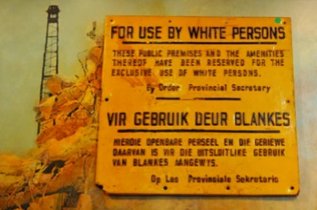 Hertzog's time in office came to a bitter end on 4th September 1939 when he sanctioned a policy of
neutrality in the looming second world war, and the United party
forced him from office replacing him with deputy prime minister
Jan Smuts, a friend and colleague of British Prime Minister
Winston Churchill. Smuts believed in racial segregation with a paternalistic
outlook; black Africans should be treated fairly but precluded
from the political process less they destroy civilisation.
Despite this, Smuts government's approach to racial segregation
softened during the war years. The Fagan Commission, set up by
Smuts, recommended in 1946 that the rules concerning black
movement in urban areas should be relaxed to provide a wider
choice of staff for business owners and also a wider consumer
base. Hertzog's time in office came to a bitter end on 4th September 1939 when he sanctioned a policy of
neutrality in the looming second world war, and the United party
forced him from office replacing him with deputy prime minister
Jan Smuts, a friend and colleague of British Prime Minister
Winston Churchill. Smuts believed in racial segregation with a paternalistic
outlook; black Africans should be treated fairly but precluded
from the political process less they destroy civilisation.
Despite this, Smuts government's approach to racial segregation
softened during the war years. The Fagan Commission, set up by
Smuts, recommended in 1946 that the rules concerning black
movement in urban areas should be relaxed to provide a wider
choice of staff for business owners and also a wider consumer
base.
However the South
African National Party responded by setting up the Sauer
Commission which recommended that segregation should rolled out
over all aspects of life in South Africa, and it was this
recommendation that formed the basis for the implementation of
Apartheid ~ apartness. By this time 75,000 black African mine
workers had gone on strike when it was revealed that they were
being paid twelve times less than their white co-workers. The
white police suppressed the strike killing or injuring more than
one thousand blacks underlined a perception that the blacks
required controlling and couldn't be trusted.
The South African National party went on to win the general
election of 1948, narrowly beating Smuts' party in the number of
seats in parliament, although it lost the popular vote. In 1950
it passed the Population Registration Act which placed all South
Africans into three racial groups, white, coloured (mixed race
or Asian), and native (African/black). The act also made it
illegal for marriages to take place between any of the three
racial groups in order to maintain racial purity. Cont/...
|

 Hertzog's time in office came to a bitter end on 4th September 1939 when he sanctioned a policy of
neutrality in the looming second world war, and the United party
forced him from office replacing him with deputy prime minister
Jan Smuts, a friend and colleague of British Prime Minister
Winston Churchill. Smuts believed in racial segregation with a paternalistic
outlook; black Africans should be treated fairly but precluded
from the political process less they destroy civilisation.
Despite this, Smuts government's approach to racial segregation
softened during the war years. The Fagan Commission, set up by
Smuts, recommended in 1946 that the rules concerning black
movement in urban areas should be relaxed to provide a wider
choice of staff for business owners and also a wider consumer
base.
Hertzog's time in office came to a bitter end on 4th September 1939 when he sanctioned a policy of
neutrality in the looming second world war, and the United party
forced him from office replacing him with deputy prime minister
Jan Smuts, a friend and colleague of British Prime Minister
Winston Churchill. Smuts believed in racial segregation with a paternalistic
outlook; black Africans should be treated fairly but precluded
from the political process less they destroy civilisation.
Despite this, Smuts government's approach to racial segregation
softened during the war years. The Fagan Commission, set up by
Smuts, recommended in 1946 that the rules concerning black
movement in urban areas should be relaxed to provide a wider
choice of staff for business owners and also a wider consumer
base. 






